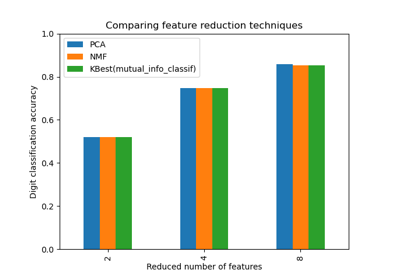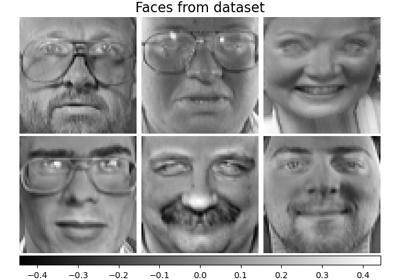-
class sklearn.decomposition.NMF(n_components=None, init=None, solver='cd', tol=0.0001, max_iter=200, random_state=None, alpha=0.0, l1_ratio=0.0, verbose=0, shuffle=False, nls_max_iter=2000, sparseness=None, beta=1, eta=0.1)[source] -
Non-Negative Matrix Factorization (NMF)
Find two non-negative matrices (W, H) whose product approximates the non- negative matrix X. This factorization can be used for example for dimensionality reduction, source separation or topic extraction.
The objective function is:
0.5 * ||X - WH||_Fro^2 + alpha * l1_ratio * ||vec(W)||_1 + alpha * l1_ratio * ||vec(H)||_1 + 0.5 * alpha * (1 - l1_ratio) * ||W||_Fro^2 + 0.5 * alpha * (1 - l1_ratio) * ||H||_Fro^2
Where:
||A||_Fro^2 = \sum_{i,j} A_{ij}^2 (Frobenius norm) ||vec(A)||_1 = \sum_{i,j} abs(A_{ij}) (Elementwise L1 norm)The objective function is minimized with an alternating minimization of W and H.
Read more in the User Guide.
Parameters: n_components : int or None
Number of components, if n_components is not set all features are kept.
init : ?random? | ?nndsvd? | ?nndsvda? | ?nndsvdar? | ?custom?
Method used to initialize the procedure. Default: ?nndsvdar? if n_components < n_features, otherwise random. Valid options:
-
- ?random?: non-negative random matrices, scaled with:
-
sqrt(X.mean() / n_components)
-
- ?nndsvd?: Nonnegative Double Singular Value Decomposition (NNDSVD)
-
initialization (better for sparseness)
-
- ?nndsvda?: NNDSVD with zeros filled with the average of X
-
(better when sparsity is not desired)
-
- ?nndsvdar?: NNDSVD with zeros filled with small random values
-
(generally faster, less accurate alternative to NNDSVDa for when sparsity is not desired)
- ?custom?: use custom matrices W and H
solver : ?pg? | ?cd?
Numerical solver to use: ?pg? is a Projected Gradient solver (deprecated). ?cd? is a Coordinate Descent solver (recommended).
New in version 0.17: Coordinate Descent solver.
Changed in version 0.17: Deprecated Projected Gradient solver.
tol : double, default: 1e-4
Tolerance value used in stopping conditions.
max_iter : integer, default: 200
Number of iterations to compute.
random_state : integer seed, RandomState instance, or None (default)
Random number generator seed control.
alpha : double, default: 0.
Constant that multiplies the regularization terms. Set it to zero to have no regularization.
New in version 0.17: alpha used in the Coordinate Descent solver.
l1_ratio : double, default: 0.
The regularization mixing parameter, with 0 <= l1_ratio <= 1. For l1_ratio = 0 the penalty is an elementwise L2 penalty (aka Frobenius Norm). For l1_ratio = 1 it is an elementwise L1 penalty. For 0 < l1_ratio < 1, the penalty is a combination of L1 and L2.
New in version 0.17: Regularization parameter l1_ratio used in the Coordinate Descent solver.
shuffle : boolean, default: False
If true, randomize the order of coordinates in the CD solver.
New in version 0.17: shuffle parameter used in the Coordinate Descent solver.
nls_max_iter : integer, default: 2000
Number of iterations in NLS subproblem. Used only in the deprecated ?pg? solver.
Changed in version 0.17: Deprecated Projected Gradient solver. Use Coordinate Descent solver instead.
sparseness : ?data? | ?components? | None, default: None
Where to enforce sparsity in the model. Used only in the deprecated ?pg? solver.
Changed in version 0.17: Deprecated Projected Gradient solver. Use Coordinate Descent solver instead.
beta : double, default: 1
Degree of sparseness, if sparseness is not None. Larger values mean more sparseness. Used only in the deprecated ?pg? solver.
Changed in version 0.17: Deprecated Projected Gradient solver. Use Coordinate Descent solver instead.
eta : double, default: 0.1
Degree of correctness to maintain, if sparsity is not None. Smaller values mean larger error. Used only in the deprecated ?pg? solver.
Changed in version 0.17: Deprecated Projected Gradient solver. Use Coordinate Descent solver instead.
Attributes: components_ : array, [n_components, n_features]
Non-negative components of the data.
reconstruction_err_ : number
Frobenius norm of the matrix difference between the training data and the reconstructed data from the fit produced by the model.
|| X - WH ||_2n_iter_ : int
Actual number of iterations.
References
C.-J. Lin. Projected gradient methods for non-negative matrix factorization. Neural Computation, 19(2007), 2756-2779. http://www.csie.ntu.edu.tw/~cjlin/nmf/
Cichocki, Andrzej, and P. H. A. N. Anh-Huy. ?Fast local algorithms for large scale nonnegative matrix and tensor factorizations.? IEICE transactions on fundamentals of electronics, communications and computer sciences 92.3: 708-721, 2009.
Examples
>>> import numpy as np >>> X = np.array([[1,1], [2, 1], [3, 1.2], [4, 1], [5, 0.8], [6, 1]]) >>> from sklearn.decomposition import NMF >>> model = NMF(n_components=2, init='random', random_state=0) >>> model.fit(X) NMF(alpha=0.0, beta=1, eta=0.1, init='random', l1_ratio=0.0, max_iter=200, n_components=2, nls_max_iter=2000, random_state=0, shuffle=False, solver='cd', sparseness=None, tol=0.0001, verbose=0)
>>> model.components_ array([[ 2.09783018, 0.30560234], [ 2.13443044, 2.13171694]]) >>> model.reconstruction_err_ 0.00115993...Methods
fit(X[, y])Learn a NMF model for the data X. fit_transform(X[, y, W, H])Learn a NMF model for the data X and returns the transformed data. get_params([deep])Get parameters for this estimator. inverse_transform(W)Transform data back to its original space. set_params(\*\*params)Set the parameters of this estimator. transform(X)Transform the data X according to the fitted NMF model -
__init__(n_components=None, init=None, solver='cd', tol=0.0001, max_iter=200, random_state=None, alpha=0.0, l1_ratio=0.0, verbose=0, shuffle=False, nls_max_iter=2000, sparseness=None, beta=1, eta=0.1)[source]
-
fit(X, y=None, **params)[source] -
Learn a NMF model for the data X.
Parameters: X: {array-like, sparse matrix}, shape (n_samples, n_features) :
Data matrix to be decomposed
Returns: self :
-
fit_transform(X, y=None, W=None, H=None)[source] -
Learn a NMF model for the data X and returns the transformed data.
This is more efficient than calling fit followed by transform.
Parameters: X: {array-like, sparse matrix}, shape (n_samples, n_features) :
Data matrix to be decomposed
W : array-like, shape (n_samples, n_components)
If init=?custom?, it is used as initial guess for the solution.
H : array-like, shape (n_components, n_features)
If init=?custom?, it is used as initial guess for the solution.
Returns: W: array, shape (n_samples, n_components) :
Transformed data.
-
get_params(deep=True)[source] -
Get parameters for this estimator.
Parameters: deep : boolean, optional
If True, will return the parameters for this estimator and contained subobjects that are estimators.
Returns: params : mapping of string to any
Parameter names mapped to their values.
-
inverse_transform(W)[source] -
Transform data back to its original space.
Parameters: W: {array-like, sparse matrix}, shape (n_samples, n_components) :
Transformed data matrix
Returns: X: {array-like, sparse matrix}, shape (n_samples, n_features) :
Data matrix of original shape
.. versionadded:: 0.18 :
-
set_params(**params)[source] -
Set the parameters of this estimator.
The method works on simple estimators as well as on nested objects (such as pipelines). The latter have parameters of the form
<component>__<parameter>so that it?s possible to update each component of a nested object.Returns: self :
-
transform(X)[source] -
Transform the data X according to the fitted NMF model
Parameters: X: {array-like, sparse matrix}, shape (n_samples, n_features) :
Data matrix to be transformed by the model
Returns: W: array, shape (n_samples, n_components) :
Transformed data
-
decomposition.NMF()
Examples using
2025-01-10 15:47:30



Please login to continue.